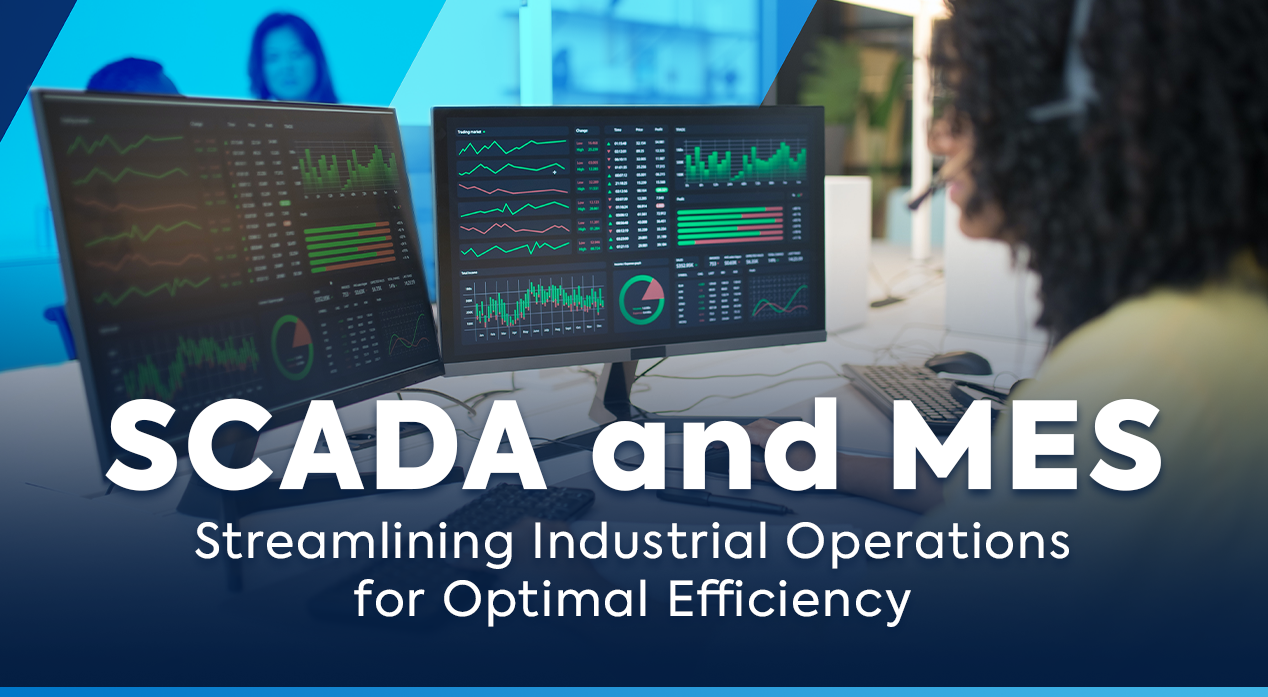SCADA and MES: Streamlining Industrial Operations for Optimal Efficiency

In today's industrial landscape, companies often rely on powerful systems like SCADA (Supervisory Control and Data Acquisition) and MES (Manufacturing Execution System) to streamline monitoring, control, and to optimize overall factory efficiency. While these solutions operate at different levels, they offer unique advantages as standalone systems, as well as being paired within a digital ecosystem.

At a glance, SCADA serves to enable efficient monitoring and control of industrial processes. With the use of SCADA, you can supervise and control critical processes across multiple locations, ensuring operational continuity and minimizing downtime. By pairing the integration with sensors, actuators, and other devices, SCADA systems facilitate data acquisition, enabling you to capture and analyze essential information about your production environment in real time. Its intuitive graphical interface provides a comprehensive visualization of industrial operations, allowing your operators to monitor real-time data, track KPIs (key performance indicators), and promptly identify potential issues. This visibility enables informed decision-making and swift action to optimize productivity and enhance overall efficiency
At a glance, SCADA serves to enable efficient monitoring and control of industrial processes. With the use of SCADA, you can supervise and control critical processes across multiple locations, ensuring operational continuity and minimizing downtime. By pairing the integration with sensors, actuators, and other devices, SCADA systems facilitate data acquisition, enabling you to capture and analyze essential information about your production environment in real time. Its intuitive graphical interface provides a comprehensive visualization of industrial operations, allowing your operators to monitor real-time data, track KPIs (key performance indicators), and promptly identify potential issues. This visibility enables informed decision-making and swift action to optimize productivity and enhance overall efficiency

On the other hand, the MES operates at the manufacturing process level, focusing on driving efficiency throughout the factory floor. It empowers engineers and operators by optimizing task loads performed in their respective roles. By integrating an MES, you gain the ability to proactively adapt to changing circumstances by effectively managing assets and variables within your operational ecosystem. A seamless integration with ERP systems allows you to manage production in terms of work order completion, comprehensive quality tracking, and genealogy. By continuously collecting and analyzing precise production data and providing simplified visual representations of essential parameters, the MES enables you to make informed adjustments to optimize just about everything to do with manufacturing.
On the other hand, the MES operates at the manufacturing process level, focusing on driving efficiency throughout the factory floor. It empowers engineers and operators by optimizing task loads performed in their respective roles. By integrating an MES, you gain the ability to proactively adapt to changing circumstances by effectively managing assets and variables within your operational ecosystem. A seamless integration with ERP systems allows you to manage production in terms of work order completion, comprehensive quality tracking, and genealogy. By continuously collecting and analyzing precise production data and providing simplified visual representations of essential parameters, the MES enables you to make informed adjustments to optimize just about everything to do with manufacturing.
The Advantages of Interoperability
While SCADA and MES offer distinct advantages independently, their interoperability creates a comprehensive view of the entire manufacturing process. By integrating data from both systems, manufacturers can gain a better understanding of equipment performance and make more informed decisions to optimize operations. They combine to bridge the gap between equipment control and operation optimization, effectively unlocking new approaches to your productivity and efficiency.
A key difference between MES and SCADA is their level of detail. MES solutions, providing a high-level overview of the entire manufacturing process, allows you to stay on top of scheduling, production tracking, and quality control. In contrast, SCADA systems are focused on the real-time monitoring and control of specific equipment, allowing your operators to adjust as needed to ensure a smooth and continuous production.

Unlocking Operational Excellence
The high-level overview provided by MES solutions combined with the real-time monitoring and control capabilities of SCADA systems, enable manufacturers to gain a comprehensive view of their operations and make more informed decisions. Overall, the ecosystem offers a multitude of advantages, such as:

Real-time Visibility and Control:
- SCADA provides a real-time monitoring and control capabilities of machinery, where operators can monitor critical parameters, KPIs, and identify issues promptly.
- The MES complements this by managing the entire manufacturing process, optimizing planning, scheduling, and resource allocation, leading to an enhanced efficiency and productivity.

Comprehensive Data Analysis:
- SCADA captures real-time data, while MES offers robust data logging and historical trending capabilities.
- Their synergy enables analysis of trends, detection of patterns, and valuable insights into processes.
- And supports data-backed decision-making, optimization of performance, and driving operational excellence.

Enhanced Safety, Security, and Compliance:
- Built-in alarm management promptly notifies operators of critical events or deviations from predefined parameters.
- Supports secure communication protocols, authentication mechanisms, and access control features.
- Safeguards the integrity and confidentiality of data.
- Provides documentation management, electronic record-keeping, and automated reporting capabilities for regulatory compliance.
Conclusion
The integration of SCADA and MES unlocks numerous advantages, propelling industrial operations towards operational excellence. Real-time visibility, data analysis capabilities, and enhanced safety and compliance empower businesses to optimize processes, improve decision-making, and thrive in today's complex manufacturing landscape. Embrace the powerful synergy of SCADA and MES and unleash the full potential of your industrial operations.

Join the Future of Manufacturing
Don’t get left behind in the rapidly evolving manufacturing industry 4.0. Partner with Premier Tech Digital and unlock the potential of Industry 4.0 with our solutions and expertise. Experience the future of manufacturing today!






